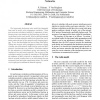901 search results - page 54 / 181 » Minimum power configuration in wireless sensor networks |
WIOPT
2005
IEEE
14 years 2 months ago
2005
IEEE
The log-normal shadowing radio model has frequently been used to model radio propagation conditions. There exist accurate calculation methods for estimation of interference power ...
ICCCN
2007
IEEE
14 years 3 months ago
2007
IEEE
Abstract— With the rapid deployment of wireless sensor networks, there are several new sensing applications with specific requirements. Specifically, target tracking applicatio...
NANONET
2009
Springer
14 years 3 months ago
2009
Springer
We present a vision and preliminary results for a combined RF-Biological Systems where the Electro-Magnetic energy of RF signals is transduced into control-signals for biological s...
FCCM
2009
IEEE
14 years 3 months ago
2009
IEEE
—Wireless sensor networks (WSNs) are typically composed of very small, battery-operated devices (sensor nodes) containing simple microprocessors with few computational resources....
APNOMS
2006
Springer
14 years 14 days ago
2006
Springer
This paper proposes a policy-based management framework for self-managed wireless sensor networks (WSNs) called SNOWMAN (SeNsOr netWork MANagement). In WSNs, a number of sensor nod...

